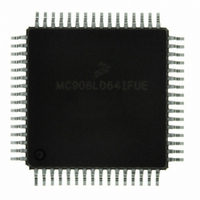MC908LD64IFUE Freescale Semiconductor, MC908LD64IFUE Datasheet - Page 97

MC908LD64IFUE
Manufacturer Part Number
MC908LD64IFUE
Description
IC MCU 8BIT FOR LCD 64-QFP
Manufacturer
Freescale Semiconductor
Series
HC08r
Datasheet
1.MC908LD64IFUE.pdf
(362 pages)
Specifications of MC908LD64IFUE
Core Processor
HC08
Core Size
8-Bit
Speed
6MHz
Connectivity
I²C, USB
Peripherals
OSD, POR, PWM
Number Of I /o
39
Program Memory Size
60KB (60K x 8)
Program Memory Type
FLASH
Ram Size
2K x 8
Voltage - Supply (vcc/vdd)
3 V ~ 3.6 V
Data Converters
A/D 6x8b
Oscillator Type
Internal
Operating Temperature
0°C ~ 85°C
Package / Case
64-QFP
Processor Series
HC08LD
Core
HC08
Data Bus Width
8 bit
Data Ram Size
2 KB
Interface Type
I2C, USB
Maximum Clock Frequency
6 MHz
Number Of Programmable I/os
39
Number Of Timers
2
Maximum Operating Temperature
+ 85 C
Mounting Style
SMD/SMT
Development Tools By Supplier
FSICEBASE, M68CBL05CE
Minimum Operating Temperature
0 C
On-chip Adc
8 bit, 6 Channel
Lead Free Status / RoHS Status
Lead free / RoHS Compliant
Eeprom Size
-
Lead Free Status / Rohs Status
Details
Available stocks
Company
Part Number
Manufacturer
Quantity
Price
Company:
Part Number:
MC908LD64IFUE
Manufacturer:
Freescale Semiconductor
Quantity:
10 000
Part Number:
MC908LD64IFUE
Manufacturer:
FREESCALE
Quantity:
20 000
- Current page: 97 of 362
- Download datasheet (2Mb)
7.4 I/O Signals
7.4.1 Crystal Amplifier Input Pin (OSC1)
7.4.2 Crystal Amplifier Output Pin (OSC2)
7.4.3 Oscillator Enable Signal (SIMOSCEN)
7.4.4 External Clock Source (OSCXCLK)
7.4.5 Oscillator Out (OSCOUT)
MC68HC908LD64
Freescale Semiconductor
—
Rev. 3.0
The following paragraphs describe the oscillator I/O signals.
The OSC1 pin is an input to the crystal oscillator amplifier.
An externally generated clock also can feed the OSC1 pin of the crystal
oscillator circuit. Connect the external clock to the OSC1 pin and let the
OSC2 pin float.
The OSC2 pin is the output of the crystal oscillator inverting amplifier.
The SIMOSCEN signal comes from the SIM and enables the oscillator.
OSCXCLK is the crystal oscillator output signal. It runs at the full speed
of the crystal (f
Figure 7-1
OSC2 and may not represent the actual circuitry. The duty cycle of
OSCXCLK is unknown and may depend on the crystal and other
external factors. Also, the frequency and amplitude of OSCXCLK can be
unstable at start-up.
The clock driven to the SIM is the crystal frequency divided by two. This
signal is driven to the SIM for generation of the bus clocks used by the
CPU and other modules on the MCU. OSCOUT will be divided again in
the SIM and results in the internal bus frequency being one fourth of the
OSCXCLK frequency.
shows only the logical relation of OSCXCLK to OSC1 and
XCLK
Oscillator (OSC)
) and comes directly from the crystal oscillator circuit.
Oscillator (OSC)
Data Sheet
I/O Signals
97
Related parts for MC908LD64IFUE
Image
Part Number
Description
Manufacturer
Datasheet
Request
R
Part Number:
Description:
Manufacturer:
Freescale Semiconductor, Inc
Datasheet:
Part Number:
Description:
Manufacturer:
Freescale Semiconductor, Inc
Datasheet:
Part Number:
Description:
Manufacturer:
Freescale Semiconductor, Inc
Datasheet:
Part Number:
Description:
Manufacturer:
Freescale Semiconductor, Inc
Datasheet:
Part Number:
Description:
Manufacturer:
Freescale Semiconductor, Inc
Datasheet:
Part Number:
Description:
Manufacturer:
Freescale Semiconductor, Inc
Datasheet:
Part Number:
Description:
Manufacturer:
Freescale Semiconductor, Inc
Datasheet:
Part Number:
Description:
Manufacturer:
Freescale Semiconductor, Inc
Datasheet:
Part Number:
Description:
Manufacturer:
Freescale Semiconductor, Inc
Datasheet:
Part Number:
Description:
Manufacturer:
Freescale Semiconductor, Inc
Datasheet:
Part Number:
Description:
Manufacturer:
Freescale Semiconductor, Inc
Datasheet:
Part Number:
Description:
Manufacturer:
Freescale Semiconductor, Inc
Datasheet:
Part Number:
Description:
Manufacturer:
Freescale Semiconductor, Inc
Datasheet:
Part Number:
Description:
Manufacturer:
Freescale Semiconductor, Inc
Datasheet:
Part Number:
Description:
Manufacturer:
Freescale Semiconductor, Inc
Datasheet:











